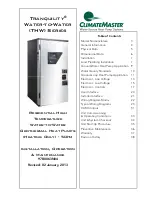
T H E S M A R T S O L U T I O N F O R E N E R G Y E F F I C I E N C Y
7
c l i m a t e m a s t e r. c o m
Tr a n q u i l i t y
®
W a t e r- t o - W a t e r T H W S e r i e s
R e v i s e d : 0 2 J a n u a r y, 2 0 1 3
The applications are too varied to describe in this
document, however some basic guidelines will be
presented. All plumbing should conform to local codes
and consider the following:
Wide temperature variation applications such as
heating/cooling coils
- Employ piping materials that are rated for the
maximum temperature and pressure combination.
This excludes PVC for most heating applications.
- Insure load water fl ow in high temperature heating
applications is at least 3.2 l/m per kW to improve
performance and reduce nuisance high pressure
faults.
- DO NOT employ plastic to metal threaded joints
- Utilize a pressure tank and air separator vent system
to equalize pressure and remove air.
Swimming Pool Hot Tub Applications
- Recommended application includes a brazed plate
heat exchanger to isolate pool water from the unit
heat exchanger.
Potable Water Applications
- Insure load water fl ow in high temperature heating
applications is at least 3.2 l/m per kW to improve
performance and reduce nuisance high pressure
faults.
- A secondary heat exchanger must always be used
between the water-to-water heat pump and potable
water tank. Either an indirect water heat or brazed
plate heat exchanger (with a secondary pump) will
isolate the potable water from the heating water.
Load Plumbing Installation
Installation
THW Unit Location
These units are not designed for outdoor installation.
Locate the unit in an INDOOR area that allows
enough space for service personnel to perform typical
maintenance or repairs.
The installation of water source heat pump units and all
associated components, parts and accessories which
make up the installation shall be in accordance with
the regulations of ALL authorities having jurisdiction
and MUST conform to all applicable codes. It is the
responsibility of the Installing Contractor to determine
and comply with ALL applicable codes and regulations.
Locate the unit in an indoor area that allows easy
removal of access panels, and has enough space for
service personnel to perform maintenance or repair.
Provide suffi cient room to make water and electrical
connections. Any access panel screws that would be
diffi cult to remove after the unit is installed should be
removed prior to setting the unit. These units are not
approved for outdoor installation and, therefore, must
be installed inside the structure being conditioned.
Do not locate in areas where ambient conditions are
not maintained within 4-38°C and up to 75% relative
humidity.
/RDG+;
EU]SOW
,1
287
287
+7*
'+:
0
'+:
,1
+7*
7R
'+:
6WRUDJH
7DQN
Load Piping Connections
Load piping connections are designated ‘Load Water In
and Out’ for the radiant heating system piping, and ‘DHW
Water In and Out’ (optional) for connection to the domestic
hot water piping. Any unused piping connections on the
load side of the THW unit will allow spillage of the load
circuit fl uid, as the radiant and DHW circuits are connected
internally.
If a unit is ordered with the DHW option and is not being
connected to a radiant heating system, the ‘Load Water
In and Out’ (radiant heating circuit) connections must be
connected to the ‘DHW In and Out’ piping using tees as
shown in Figure 1a. Failure to do so will lead to nuisance
high-pressure faults.
THW Unit Load Plumbing
Figure 1a: THW DHW Only Piping






















